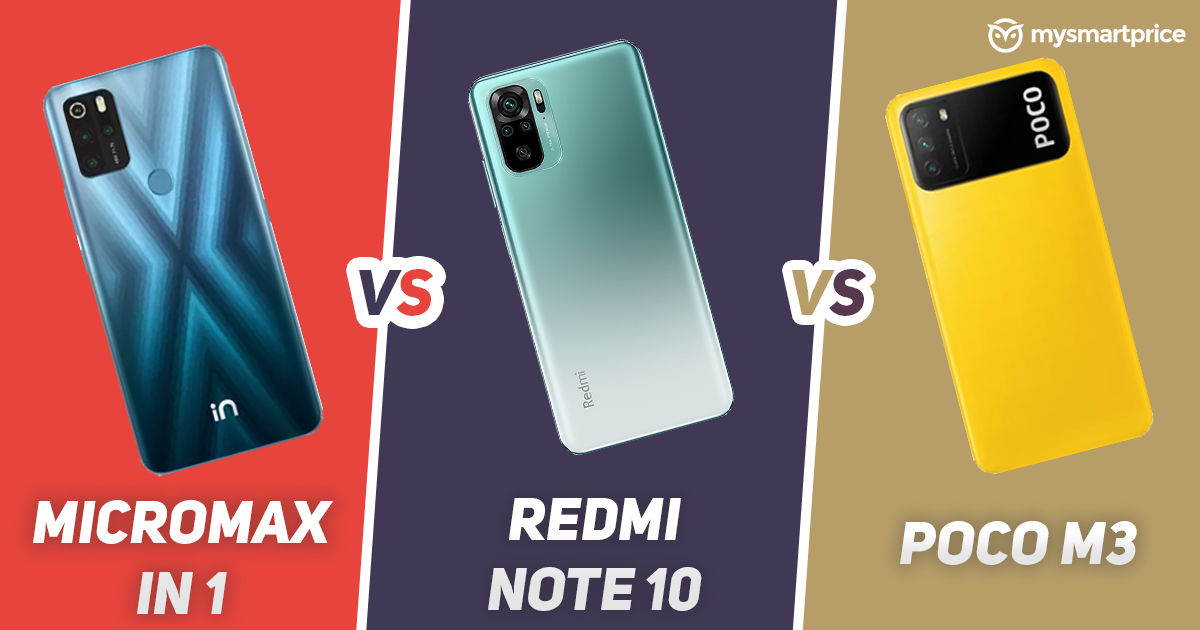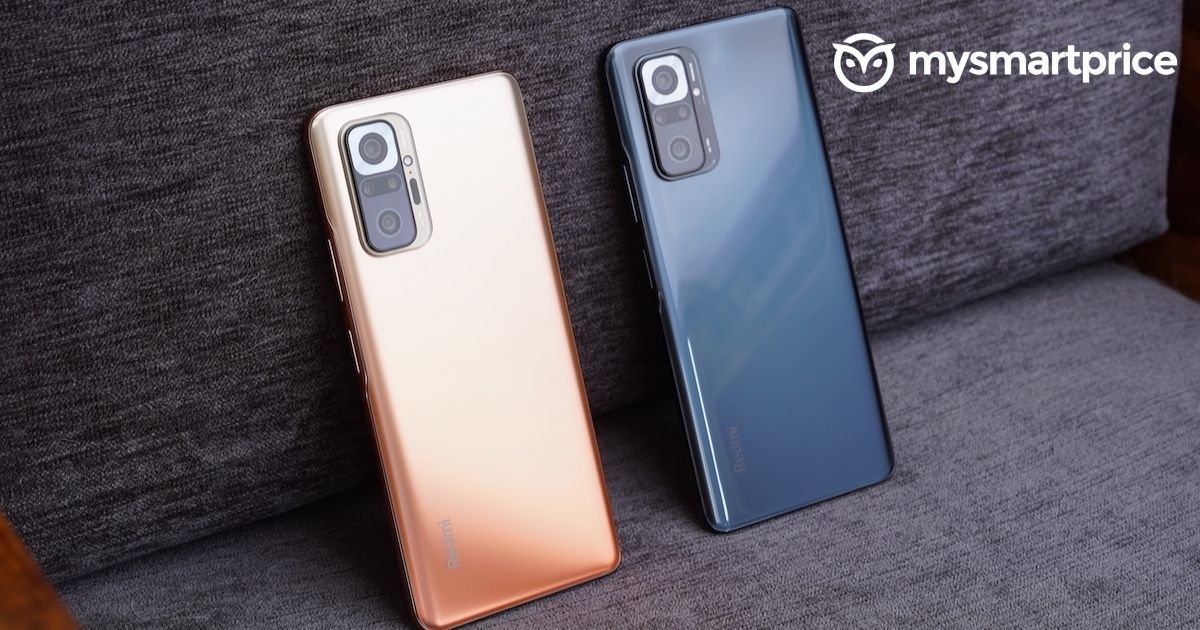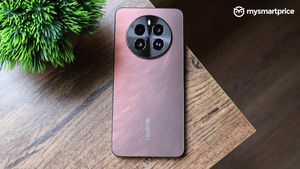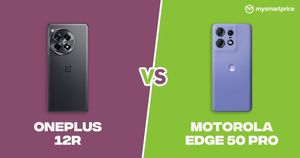
The Micromax In 1 represents the Indian OEM’s third effort at revival, after launching the In Note 1 and In 1b earlier. While all three of its phones are essentially targeted at about the same price band, the Micromax In 1 has been launched into a competition that includes venerable options from Xiaomi’s stable. This competition includes two offerings from two Xiaomi sub-brands – the Poco M3 and the Redmi Note 10. Given the already established popularity of the Redmi Note series in India, and Poco’s growing stature, can the Micromax In 1 offer stiff enough competition and emerge as a winner in this category? We take a look at all the specifications and pricing of the three smartphones, to see which may make better overall sense to buy.
Micromax In 1 vs Poco M3 vs Redmi Note 10: Price in India
The Micromax In 1 comes in two variants. The 4/64GB variant of the In 1 is priced at Rs 10,499, while the 6/128GB variant costs Rs 11,999. During its first sale via Flipkart on March 26, the In 1 will have an introductory pricing of Rs 9,999 and Rs 11,499 for the two variants, respectively.
The Poco M3 came in as India’s most affordable 6GB RAM phone, and it continues to hold on to this tag. It gets two variants – 6/64GB and 6/128GB, which cost Rs 10,999 and Rs 11,999 respectively.
The Redmi Note 10 is slightly more expensive, and costs Rs 11,999 for the base 4/64GB variant, and Rs 13,999 for the 6/128GB variant.
Micromax In 1 vs Poco M3 vs Redmi Note 10: Design and Display
The Micromax In 1 features a similar rear panel design in comparison to its previous offering, the In Note 1. This includes an inlaid X-shaped pattern on the back. The rear camera module is neatly tucked but for some reason still feels the need to mention ‘AI’ wrapped in an aperture symbol. Apart from that, the In 1 features a punch-hole slot in the front for the front camera, measures 9mm in thickness and 195g in weight, and will be available in blue and purple colours. Micromax also employs a 6.67-inch LCD display, bringing to the phone full HD+ screen resolution, 20:9 aspect ratio and 440 nits typical brightness.
In comparison, the Poco M3 has a unique triple rear camera module design that also looks more appealing and proportionate that the corner camera modules. Despite the drop-notch accommodating the front camera, the Poco M3 looks quite premium even from the front. At 9.6mm width and 196g weight, it is slightly bulkier than the Micromax In 1. Three colour variants – Cool Blue, Poco Yellow and Power Black make for pretty decent, solid colour options. This is topped off with a 6.53-inch full HD+ LCD display, with 400 nits typical brightness and 19.5:9 aspect ratio. As a result, the Poco M3 is shorter than Micromax’s offering.
The Redmi Note 10 is the sleekest smartphone of the bunch here. It measures 8.3mm in width and 178g in weight, hence being the lightest and slimmest of the three. It uses a drill hole notch, and a tidy corner camera module that doesn’t look awkward. It features minimal branding at the back, and three colour choices – Shadow Black, Frost White and Aqua Green, which include gradient colour options. It also has the most compact display of the bunch – 6.43-inch full HD+ LCD with 450 nits typical brightness at 20:9 aspect ratio. It is therefore large enough, but at the same time the sleekest and most sharp in terms of pixel density.
Micromax In 1 vs Poco M3 vs Redmi Note 10: Performance and Software
The Micromax In 1 is powered by the Helio G80 SoC from MediaTek, paired with 4GB or 6GB of RAM, and 64GB or 128GB of storage. The smartphone uses a basic eMMC 5.1 flash storage standard, and comes with the usual support for Wi-Fi 6, 4G and Bluetooth 5.0, in terms of connectivity. There is a 5,000mAh battery with 18W fast charging, and a rear-mounted physical fingerprint sensor for biometric authentication. It runs on a near-stock version of Android 10.
The Poco M3, meanwhile, features the Qualcomm Snapdragon 662 mid-range chipset, which is rated as a better overall SoC than the Helio G80 onboard Micromax’s offering. It gets 6GB RAM, and up to 128GB storage as well. It also uses a faster UFS 2.2 standard storage media. Other features include the usual connectivity features, a side-mounted fingerprint sensor, and a larger 6,000mAh battery with 18W fast charging, and reverse charging as well. The Poco M3 runs on MIUI 12, based on Android 11.
In comparison, the Redmi Note 10 is powered by the Snapdragon 678 SoC, also with up to 6GB RAM and 128GB storage. Benchmarks and specifications peg this chipset as the most powerful among the three here. Connectivity features remain standard, and the fingerprint sensor here is side-mounted. However, the Redmi Note 10 gets faster fast charging standard, with 33W charging. This can juice up the smartphone’s battery life by 50 percent in just 25 minutes. Like the Poco M3, the Redmi Note 10 is also powered by MIUI 12 based on Android 11.
Micromax In 1 vs Poco M3 vs Redmi Note 10: Camera
The Micromax In 1 features a triple rear camera setup with a 48MP main sensor, a 2MP macro unit and a 2MP depth unit. It is capable of full HD video recording at 30fps, which is also possible with the 8MP front camera at hand.
The Poco M3 features the same camera configuration for both the front and rear cameras as the Micromax In 1, which too offers the same full HD video recording standard.
The Redmi Note 10 features the most well versed camera configuration in this list, which includes a 48MP quad rear camera setup. This also includes an 8MP ultra-wide camera, a 2MP macro unit and a 2MP depth unit. The front camera features a 13MP camera. From the rear camera, users can record 4K videos at 30fps, and full HD videos at 60fps.
Micromax In 1 vs Poco M3 vs Redmi Note 10: Summary
On overall terms, the Micromax In 1 offers the biggest display of the bunch, and is largely up to speed in terms of the industry standard of features. The Poco M3 offers the best battery backup of the bunch, and also has a unique design on offer. The Redmi Note 10, meanwhile, appears to be the most well balanced in terms of overall features, possibly making it the standout offering in this comparison, despite a higher price.

















